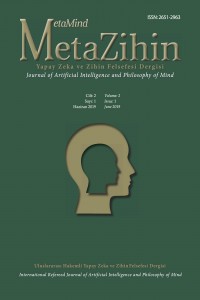Abstract
Öz: Tam
rüya görürken uykudan uyanacak olursak rüyamızın içeriğini kısmen hatırlarız
ama bu hatırlama genellikle çok çabuk sona erer. Eğer rüyamız bizim için son
derece ilginç veya şok edici bir nitelik taşımıyor ya da onu hatırlamak için
bilinçli bir çaba harcamıyorsak—örneğin rüyamızı bir yere not ederek—rüyamız
hafızamızdan çabucak silinir. Bu çabucak silinmenin nedeni konusunda bir
açıklama öneriyorum. Fakat rüya içeriğinin başlangıçta hafızamızdan hızlıca
siliniyor görünmesine rağmen, bazı rüyalarımızın hiç değilse bazı kısımları bir
müddet zihnimizde kalmaya devam eder, ama bu kısımları ancak nadir durumlarda
hatırlarız. Bazı rüya bölümlerinin hafızamızdaki bu “derin depolanışı” ve
rüyalarla ilgili başka bazı olguların, rüyaların beynin uyku sırasındaki birtakım
operasyonları sonucu ortaya çıkan işe yaramaz yan ürünler olduğu şeklindeki
görüşe karşı kanıt oluşturduğunu savunuyorum.
References
- Antrobus, J. (1993). “Dreaming: Could We Do without It?” In A. Moffitt, M. Kramer, and R. Hoffman (eds.), The Functions of Dreaming (pp. 549-558). New York: SUNY Press.
- Crick, F., and Mitchinson, G. (1983). “The Function of Dream Sleep.” Nature, 304: 111-114.
- Crick, F., and Mitchinson, G. (1995). “REM Sleep and Neural Nets.” Behavioural Brain Research, 69: 147-155.
- Flanagan, O. (1995). “Deconstructing Dreams: The Spandrels of Sleep.” The Journal of Philosophy, 92: 5-27.
- Flanagan, O. (2000). Dreaming Souls: Sleep, Dreams, and the Evolution of the Conscious Mind. New York: Oxford University Press.
- Foulkes, D. (1985). Dreaming: A Cognitive-Psychological Analysis. Hillsdale, NJ: Erlbaum.
- Hobson, J. A. (1988). The Dreaming Brain. New York: Basic Books.
- Hobson, J. A., (2003). The Dream Drugstore: Chemically Altered States of Consciousness. Cambridge, MA: The MIT Press.
- Hobson, J. A., and McCarley, R. W. (1977). “The Brain as a Dream-State Generator: An Activation-Synthesis Hypothesis of the Dream Process.” The American Journal of Psychiatry, 134: 1335-1348.
- Kemp, S., Burt, C. D. B., and Sheen, M. (2003). “Remembering Dreamt and Actual Experiences.” Applied Cognitive Psychology, 17: 577-591.
- Rassin, E., Merckelbach, H., and Spaan, V. (2001). “When Dreams Become a Royal Road to Confusion: Realistic Dreams, Dissociation, and Fantasy Proneness.” Journal of Nervous and Mental Disease, 189: 478-481.
- Revonsuo, A., and Valli, K. (2000). “Dreaming and Consciousness: Testing the Threat Simulation Theory of the Function of Dreaming.” Psyche, 6(8): Retrieved from https://pdfs.semanticscholar.org/9788/5aebc97eaeb20c5537b5752f9ca7a0fa589e.pdf
- Wallace, I. (2009). “Who Dreams Wins.” Retrieved on 25 June 2019 from http://ianwallacedreams.com/who-dreams-wins/
Abstract
Abstract: If we wake up during a dream, we remember the
contents of our dream, but generally only for the blink of an eye. Our dream is
quickly erased from our memory unless the dream was highly interesting or
shocking for us or we spend conscious effort to remember it—by jotting it down
in a dream diary, for example. An explanation is proposed of why this hasty
erasure happens. Despite the apparent initial erasure of dream contents from
our memory, we seem to retain at least fragments of some of our dreams for some
time, although those fragments are recalled only in certain rare circumstances.
This “deep storage” of portions of some of our dreams in our memory, conjoined
with certain other facts about dreams, is evidence against the view that dreams
are useless side-products of the brain’s operations during sleep.
References
- Antrobus, J. (1993). “Dreaming: Could We Do without It?” In A. Moffitt, M. Kramer, and R. Hoffman (eds.), The Functions of Dreaming (pp. 549-558). New York: SUNY Press.
- Crick, F., and Mitchinson, G. (1983). “The Function of Dream Sleep.” Nature, 304: 111-114.
- Crick, F., and Mitchinson, G. (1995). “REM Sleep and Neural Nets.” Behavioural Brain Research, 69: 147-155.
- Flanagan, O. (1995). “Deconstructing Dreams: The Spandrels of Sleep.” The Journal of Philosophy, 92: 5-27.
- Flanagan, O. (2000). Dreaming Souls: Sleep, Dreams, and the Evolution of the Conscious Mind. New York: Oxford University Press.
- Foulkes, D. (1985). Dreaming: A Cognitive-Psychological Analysis. Hillsdale, NJ: Erlbaum.
- Hobson, J. A. (1988). The Dreaming Brain. New York: Basic Books.
- Hobson, J. A., (2003). The Dream Drugstore: Chemically Altered States of Consciousness. Cambridge, MA: The MIT Press.
- Hobson, J. A., and McCarley, R. W. (1977). “The Brain as a Dream-State Generator: An Activation-Synthesis Hypothesis of the Dream Process.” The American Journal of Psychiatry, 134: 1335-1348.
- Kemp, S., Burt, C. D. B., and Sheen, M. (2003). “Remembering Dreamt and Actual Experiences.” Applied Cognitive Psychology, 17: 577-591.
- Rassin, E., Merckelbach, H., and Spaan, V. (2001). “When Dreams Become a Royal Road to Confusion: Realistic Dreams, Dissociation, and Fantasy Proneness.” Journal of Nervous and Mental Disease, 189: 478-481.
- Revonsuo, A., and Valli, K. (2000). “Dreaming and Consciousness: Testing the Threat Simulation Theory of the Function of Dreaming.” Psyche, 6(8): Retrieved from https://pdfs.semanticscholar.org/9788/5aebc97eaeb20c5537b5752f9ca7a0fa589e.pdf
- Wallace, I. (2009). “Who Dreams Wins.” Retrieved on 25 June 2019 from http://ianwallacedreams.com/who-dreams-wins/
Details
| Primary Language | English |
|---|---|
| Subjects | Philosophy |
| Journal Section | Research/Review Articles |
| Authors | |
| Publication Date | June 30, 2019 |
| Acceptance Date | April 21, 2019 |
| Published in Issue | Year 2019 Volume: 2 Issue: 1 |


